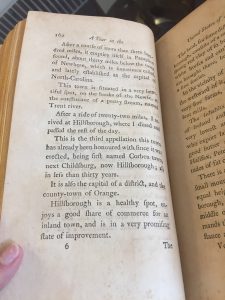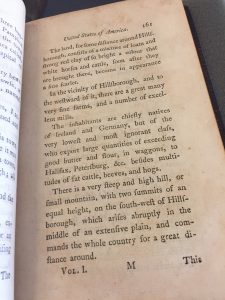
Page 160 of A Tour in the United States of America

Page 161 of A Tour in the United States of America
Smyth, J.F.D. A Tour in the United States of America : Containing an Account of the Present Sitiuation of That Country: The Population, Agriculture, Commerce, Customs, and Manners of the Inhabitants; With a Description of the Indian Nations, the General Face of the Country, Mountains, Forests, Rivers, and the Most Beautiful Grand, and Picturesque Views throughout That Vast Continent: Likewise Improvements in Husbandry That May Be Adopted with Great Advantage in Europe. Dublin: Printed by G. Perrin, for Messrs. Price, Moncrieffe [and 13 others], 1784. Vol I. Page 160-161. Wilson Library. Print.
J.F.D Smyth’s book A Tour in the United States of Americawas published in 1784. It is a travel log that recounts his experience traveling throughout the colonies of America during the American revolution. The book is a primary document that describes Smyth’s firsthand experience with the different customs, agriculture practices, commerce practices, and general layout of the land that he observed. While Smyth wrote about his findings throughout all of America, he spent a considerable amount of time exploring and writing about North Carolina. One of his stops was in Hillsborough in 1773, where he wrote about the land, people, and agricultural commerce of the area.
Smyth recorded a substantial amount of detail about the land in and around Hillsborough. For example, he described the “strong red clay” and the color it leaves on livestock. He also gave a detailed description of the terrain of Chapel Hill by describing a “very steep and high hill” that “demands the whole country for a great distance.” Additionally, Smyth described the Irish and German settlers of Hillsborough. He characterized them as low-class citizens, but crucial agents of agricultural exports.
Smyth believed Hillsborough had a “good share of commerce for an inland town” based on his firsthand account. This leads us to believe that Hillsborough produced an excess quantity of certain good and had some kind of infrastructure that facilitated trade with other cities and towns. Furthermore, it is likely that people in Hillsborough were able to acquire goods that they were unable to produce themselves. The prevalent commerce practices in Hillsborough allows us to infer that the diets of people in Hillsborough expanded beyond the flour, butter, beef, and pork that was produced there. Smyth recounts the “great many very fine farms” and the “excellent mills” of Hillsborough. From this, we can deduce that the farms and mills of Hillsborough stood out in comparison to other areas Smyth had traveled to in America. It becomes clear that Hillsborough was a hub for flour and butter production, and therefore were probably two culinary staples in the area.
Mary Grace Beard